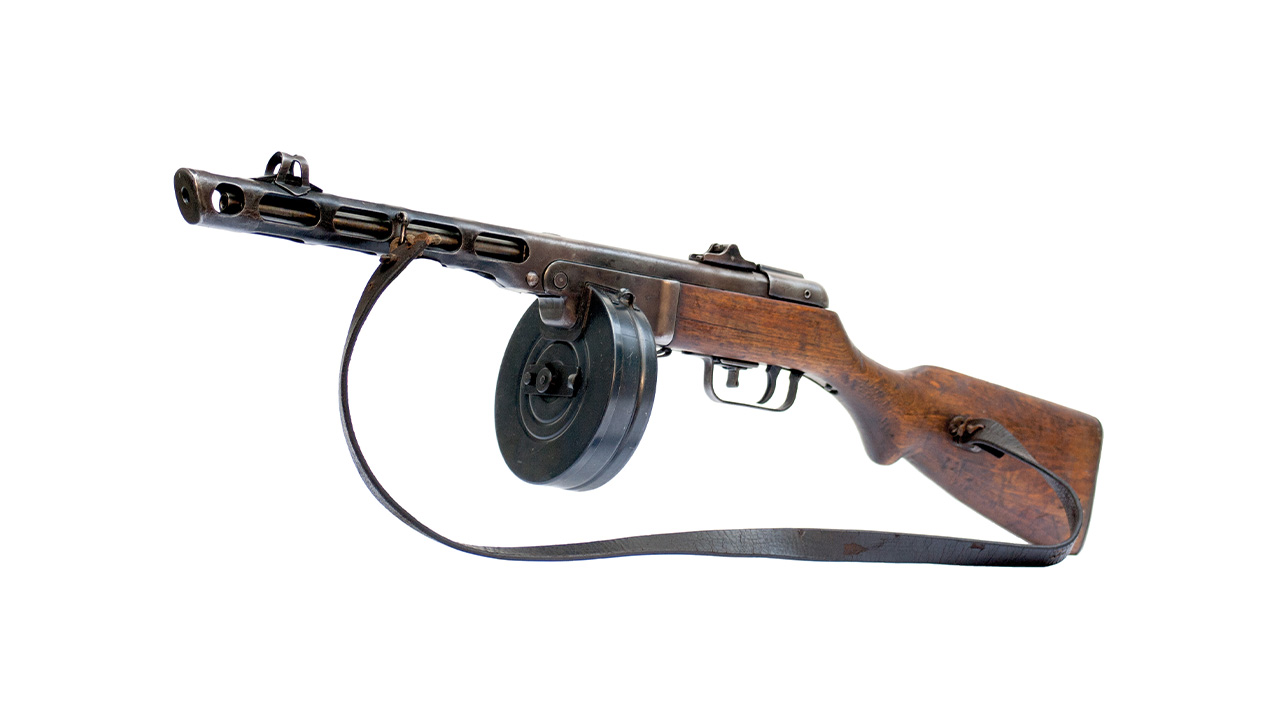Over the past decades, the Soviet PPSh-41 (Pistolet-Pulemyot Shpagina-1941) submachine gun has become a symbol of the insurgent fighter, soldier, or partisan for various reasons. However, not every insurgent had a submachine gun as his weapon – quite the opposite. Submachine guns were the weapons of commanders or specialists. Moreover, the number of submachine guns delivered by air bridge from the Soviet Union was insufficient. The basic weapon of the insurgent 1st Czechoslovak Army in Slovakia remained the rifle.
During the Second World War, there was a considerable expansion of submachine guns in the armament of almost all armies. In 1941, the Soviet Union began production of the legendary PPSh-41 (“Shpagin”) submachine guns, designed by Georgy Semyonovich Shpagin. In 1942, the PPS-43 (Pistolet-Pulemyot Sudayeva-1943) was added to the arsenal, and by the end of the war, a total of 6.5 million submachine guns had been produced in the USSR.
Submachine guns also appeared in the armament of the Slovak Army, especially the German MP-40, introduced into the armament as the model 41 submachine gun. The situation was similar during the Slovak National Uprising. The army mainly used German MP-40 submachine guns, and during the Slovak National Uprising, Soviet and American submachine guns were also supplied to the insurgents by air. In addition to the PPS-41, the USSR’s weapon supplies included PPS-43 submachine guns, as well as seized German MP-40 and MP-41 submachine guns. Archival documents give numbers ranging from 900 to 2,082 submachine guns delivered by air from the USSR, of which about 360 were German MPs. The USA brought 220 United Defence M42 submachine guns with accompanying ammunition in two trucks.
According to the memories of insurgent soldiers and partisans, the most popular machine gun was the PPSh-41; however, the German MP-40 was preferred. This was mainly due to ammunition supply. The ammunition for the Soviet submachine guns, 7.62 x 25 mm Tokarev, was flown in by air bridge and was thus relatively scarce. For the German submachine guns, there were considerably larger stocks of 9 x 19 mm Parabellum cartridges available in army depots, which were always available. Other submachine guns in the arsenal of the insurgent army, the American United Defence M42 and the Italian Berettas, were used in smaller numbers and used the same cartridges as the German weapons.
Within the 1st Czechoslovak Army in Slovakia, submachine guns were mostly assigned to officers or company and platoon commanders, or squad commanders. The VI. Tactical Group of the insurgent army had about 150 submachine guns. One of its units, the VI/53rd Infantry Battalion, had, in addition to 14 MP-40 submachine guns, six PPS-41 submachine guns in its arsenal. One of these submachine guns was assigned to the commander of VI/53rd Battalion, Capt. Tech. Arm. Avn. Svc. Daniel Kunic.
Daniel Kunic (4/11/1911 Pukanec–18/12/1991 Piešt’any) served in the Slovak Army in a variety of positions, especially in the Air Force Park at Mokraď airfield. There he served as a technical economist. After the outbreak of the SNU, he took command at Mokraď and formed an infantry battalion from the staff, which under his command took part in the defence battles. After the reorganisation of the insurgent army, it joined as VI/53rd Infantry Battalion “Lev” in the fighting near Ružomberok, where it successfully defended the area until the end of the Uprising. After the end of the war, Capt. D. Kunic rejoined the Czechoslovak Air Force, where he served until his discharge from the army in 1957.
The Museum of the Slovak National Uprising acquired the PPSh-41 submachine gun for its collections in 1967 by purchasing it from Daniel Kunic. The weapon, with serial number BM 3470, was manufactured in 1943 at the Molot plant (Вятско-Полянского машиностроительного завод Молот) and delivered to Slovakia through an air bridge.
PhDr. Marian Uhrin, PhD.
